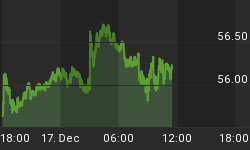Fed Brings Uncertainty
On Wednesday, the Fed minutes hinted at tapering in the months ahead. The stock market sold off on the news. Less than 24 hours later, a tame report on inflation pushed the markets back into "taper later" mode. From the Chicago Tribune:
Despite the improving growth picture, inflation remains virtually absent. In a second report, the Labor Department said its seasonally adjusted producer price index slipped 0.2 percent last month as gasoline prices tumbled, after dipping 0.1 percent in September. The decline in prices received by the nation's farms, factories and refineries was the largest since April. In the 12 months through October, wholesale prices rose 0.3 percent after advancing by the same margin in September. Wholesale prices excluding volatile food and energy costs rose 0.2 percent after nudging up 0.1 percent in September. Though labor market conditions will probably determine when the Federal Reserve will start scaling back its massive bond buying program, persistently low inflation suggests the U.S. central bank might not act until March.
Taper Later Should Be Good For Treasuries
The nuts and bolts that make up a program of quantitative easing (QE) require the Fed to buy bonds, including U.S. Treasuries. The Fed has deep pockets and can create a good bit of demand for bonds. Therefore, the decision to hold off on tapering should be good for bond prices. The question now becomes are bonds (TLT) better than stocks? On a longer-term time horizon, the answer is not yet.

A Bet On Future Economic Outcomes

When investors buy an asset, they believe it will become more valuable over time. Relative demand allows us to better understand what sectors, asset classes, or areas of the globe are rising to the top of investors' "I am confident about this" list. If the demand for stocks is greater than the demand for bonds, it tells us something about the aggregate fundamental belief investors hold about the future.
What Are Investors Confident About Now?
Our market model is highly dependent on weekly supply and demand outcomes since they filter out much of the day-to-day noise. The table below summarizes some of the current readings of how market participants view the investment landscape. Confidence is growing within many "risk-on" segments of the market. The table shows ETF performance since the October 9 low in stocks. Leadership from technology (QQQ), consumer discretionary (XLY), Europe (FEZ), and small caps (IWM) aligns with confidence in future economic outcomes, and is bullish.

The secondary leadership class is strong; just not as strong from a weekly trend perspective than their peers above. It is significant that economically sensitive sectors, such as financials (KBE) and energy (XOP), are making the leadership cut.

Defensive Assets Are Lagging
If investors were fearful of future economic outcomes or concerned about a plunge in stock prices, we would expect to see demand pick up for conservative assets relative to stocks. The table below shows just the opposite as of Thursday's close. Conservative Treasuries (TLT) have lost over 2.00% in the last six weeks.

Jobs vs. Inflation
During a speaking engagement Thursday, James Bullard took a dovish stance relative to the tone of Wednesday's Fed minutes. From Reuters:
Accommodative bond-buying must continue for now despite possible inflation risks in part because there are no signs of price rises so far, St. Louis Federal Reserve President James Bullard said on Thursday. Bullard, a voter on monetary policy this year, added he expects the U.S. central bank's balance sheet to "eventually" return to a pre-financial-crisis level of around $800 billion, though "it may take quite a while." The Fed has said it will keep buying bonds until labor-market improvement is sustainable. It has further said it will keep rates ultra-low at least until unemployment falls to 6.5 percent, as long as inflation is contained.
Investment Implications - Need To See Shift
Investors often miss opportunities to profit (case A) or remain in losing positions (case B) because they believe something will change. The self talk goes something like this:
Case A: I can't buy stocks now; they are ready to reverse.
Case B: I can't sell my bonds now; they have lost so much this year.
The charts below were originally referenced on September 19. Since they were posted, the S&P has tacked on 73 additional points. Since September 19, TLT has lost an additional 1.22%.


Focus On What Is, Not What May Be
It is much easier to make money if we assume something that is already happening will continue to occur, rather than fearing or hoping something that is not happening will begin to happen. The tables above show us that "risk-on" assets, such as foreign stocks, are leading. They also show us that "risk-off" assets are lagging. The last two sentences tell us what is happening, which means we will continue to favor stocks over bonds. We will also hold our positions in small caps (IWM) since they are clearly beating conservative Treasuries (see chart below).

One Day Does Not Make A New Trend
When the evidence changes and begins to signal a shift toward conservative or risk-off assets, we will make adjustments in line with the magnitude of the shift. Rumblings on Twitter during Wednesday's sell-off were decidedly bearish. From a weekly trend perspective, the damage Wednesday was not that meaningful. The chart below shows the demand for being long stocks vs. the demand to "go short". Wednesday's losses have had very little impact on the bigger weekly picture. In fact, at 2:51 pm EDT Thursday, the short vs. long chart below remained in the risk-on camp. Change may come, but we need to see evidence of a meaningful shift in the market's risk appetite. We will remain flexible and open minded.
















